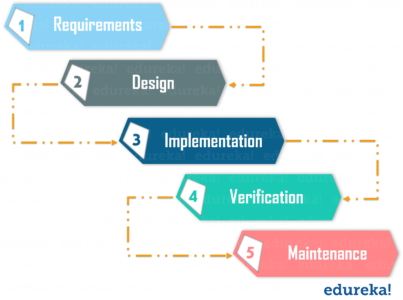DevOps Certification Training Course with Gen ...
- 190k Enrolled Learners
- Weekend
- Live Class
Are you confused about choosing the software development model for application development? Are you having a difficult time choosing between Waterfall and Agile? If yes then this blog on Waterfall vs Agile will clear all your confusion. Here we will discuss all the differences between Waterfall and Agile. After understanding the differences, it would make more sense to know about DevOps.
The topics that we will cover in this blog on Waterfall vs Agile are as follows –
The waterfall model is a model of software development that is pretty straight forward and a linear. This model follows a top-down approach. This model has various starting with Requirements gathering and analysis. This is the phase where you get the requirements from the client for developing an application. After this, you try to analyze these requirements.

Once the application is developed, it is tested in the verification phase. There are various tests conducted on the application such as unit testing, integration testing, performance testing, etc. After all the tests on the application are done, it is deployed onto the production servers. At last, comes the maintenance phase. In this phase, the application is monitored for performance. Any issues related to the performance of the application are resolved in this phase.
Agile is an iterative based software development approach where the software project is broken down into various iterations or sprints. Every iteration has phases like the waterfall model such as requirements gathering, design, development, testing, and maintenance. The duration of each iteration is generally 2-8 weeks.

So in Agile, you release the application with some high priority features in the first iteration. After its release, the end-users or the customers give you feedback about the performance of the application. The necessary changes are made into the application along with some new features and the application is again released which is the second iteration. This procedure is repeated until the desired software quality is achieved.
| Parameter | Waterfall | Agile | Comments |
| Scope | Works well when the scope is defined. Doesn’t support changes. | Suitable for projects with an unknown scope. Advocates and facilitates change. | Change is conducive as it is inevitable. But change comes at the expense of cost, effort and time. |
| Customer Input | Supports customer interaction at major milestone stages only. | Encourages customer feedback at all points during product development. | Customer involvement is beneficial to both models. |
| Team | Doesn’t require continuous team collaboration, independent performance is more emphasized. | Encourages synchronized teamwork at all stages of product development, requires teams to have skills. | Collaborative effort results in greater productivity, contracts of varying nature assigned to various vendors fail to work well under high team synchronization. |
Cost | Budget is fixed at the start, includes backup plans for identified risks. | Budget is not defined just like the scope, likely to become expensive when unforeseen changes and risks occur. | Fixed budget is good for small businesses, fixed budget can also cause a disturbance if necessary changes arise at some point in time. |
Use Waterfall if :
And use Agile if:
There is no clear winner here. You cannot say that Agile is better than Waterfall or vice versa. It really depends on the project and the level of clarity that surrounds the requirement.
You can say that Waterfall is a better model if you have a clear picture of the final product. Also, if you know that the requirement will not change and the project is relatively simple then Waterfall is for you. This model is a straightforward, efficient process if you don’t expect to deal with change.
Agile is superior When you don’t have a clear picture of the final product, when you anticipate changes at any stage of the project and when the project is pretty complex. Agile can accommodate new, evolving requirements any time during the project, whereas it is not possible Waterfall to go back to a completed phase and make changes.
This is it, this brings us to the end of this ‘Waterfall vs Agile’ blog.
Now that you have understood the difference between Waterfall and Agile, check out this DevOps training by Edureka, a trusted online learning company with a network of more than 250,000 satisfied learners spread across the globe. The Edureka DevOps Certification Training course helps learners to understand what is DevOps and gain expertise in various DevOps processes and tools such as Puppet, Jenkins, Nagios, Ansible, Chef, Saltstack and GIT for automating multiple steps in SDLC.
Got a question for us? Please mention it in the comments section and we will get back to you.
 Thank you for registering Join Edureka Meetup community for 100+ Free Webinars each month JOIN MEETUP GROUP
Thank you for registering Join Edureka Meetup community for 100+ Free Webinars each month JOIN MEETUP GROUPedureka.co